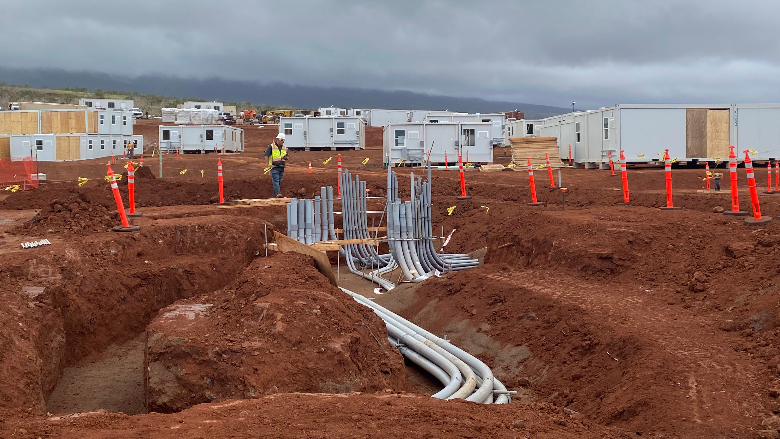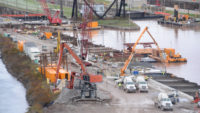Contractors hauled the first truckload of debris from homes destroyed by last year’s wildfires in Lahaina, Hawaii, on Jan. 16. The move marked the beginning of the second phase of debris removal efforts coordinated by federal, state and local officials.
The fires on Maui last August, driven by dry conditions and high winds, killed at least 100 people and did $5.5 billion in damage to thousands of structures. Thousands of residents remain displaced. Hawaii Gov. Josh Green has said debris removal may take a year and estimated its cost at $1 billion.
The U.S. Army Corps of Engineers hired Burlingame, Calif.-based contractor ECC to perform the debris removal. The initial contract is worth $64.2 million, a USACE spokesperson says, and more contracts are expected to be awarded for the work. Maui officials have estimated 400,000 cu yd of debris need to be removed.
To prevent ash and other debris from becoming airborne during transit, the contractor is using the “burrito wrapping” method, USACE officials say. The process involves wetting down material, then wrapping it in thick plastic and sealing that with an adhesive. Col. Jess Curry, recovery field office commander for USACE, said in a statement that the method has been refined with lessons learned from previous debris removal projects.
“We are dedicated to minimizing the dust produced from debris removal operations,” Curry said.
Cultural monitors are present for debris removal, and watching for any cultural resources uncovered during the process. If that happens, state officials say the monitors have the authority to stop work while they seek a resolution. In October, USACE awarded an $18.7-million contract to Honolulu-based architecture and engineering firm AEPAC for cultural monitoring during debris removal.
ECC, which has an office in Honolulu, ranks No. 75 on ENR’s 2023 Top 200 Environmental Firms list. The contractor has also been providing soil sampling and air monitoring services as part of the cleanup.
The contractor is delivering debris to a temporary disposition site near a recycling center in Olowalu, south of Lahaina on West Maui. The site selection has raised controversy in the area over contamination concerns. Maui Mayor Richard Blissen pledged this month that the Olowalu center would only be used temporarily until a permanent debris site is built, though officials have not yet identified where that would be. The temporary site is necessary for “getting survivors back to their parcels and moving recovery efforts forward,” Blissen said in a statement.
This phase of the debris removal comes after efforts to remove hazardous materials from the site. Testing last year revealed contaminants including arsenic, lead and cobalt in wildfire ash, according to the Hawaii Dept. of Health. That effort focused on items like compressed gas cylinders, pesticides and batteries that could cause safety issues during the ongoing cleanup. According to the U.S. Environmental Protection Agency, crews removed more than 220 tons of hazardous materials and 30 tons of lithium-ion batteries.
Temporary School and Housing
Other wildfire recovery efforts are also still underway. In November, USACE awarded a $53.7-million base contract to Pono Aina Management LLC of Waianae, Hawaii, for construction of a temporary elementary school campus in Lahaina for children whose school was destroyed in the fire. That project is scheduled for completion by the end of February.
 Contractors placing 337 modular units to form a temporary school campus in Lahaina. Photo by Carol Vernon/USACE Honolulu District
Contractors placing 337 modular units to form a temporary school campus in Lahaina. Photo by Carol Vernon/USACE Honolulu DistrictMore temporary housing is also needed for displaced residents. In his “state of the state” address Jan. 22, Green said the Federal Emergency Management Agency is providing 17,000 survivors with rental assistance into 2025, and the American Red Cross is helping house more than 5,000 more in 30 hotels across Maui. USACE is currently working on the design for hundreds of temporary housing units at three sites.
Jeff McCullick, USACE’s mission manager for temporary housing, said in a statement that officials could award a contract for construction at the first site as soon as February. Contracts for two other sites would follow, likely in a matter of weeks as they complete the designs. Green has also asked the owners of short-term rental units to offer their properties as temporary housing, with the state offering to cover the fair market value of each rental for two years plus an 18-month property tax exemption.
The Maui Dept. of Water Supply is also continuing its efforts to clear water as safe for unrestricted use. Officials had issued unsafe water advisories in the wake of the fires over contamination concerns. On Jan. 19, the department cleared another section of Lahaina for normal water use, though some areas remain under advisories.
“As we move forward, we will continue to remove the debris in West Maui safely and respectfully,” Green said in his address. “And the plan is to listen to the people of Lahaina and rebuild the way they want to rebuild.”






Post a comment to this article
Report Abusive Comment